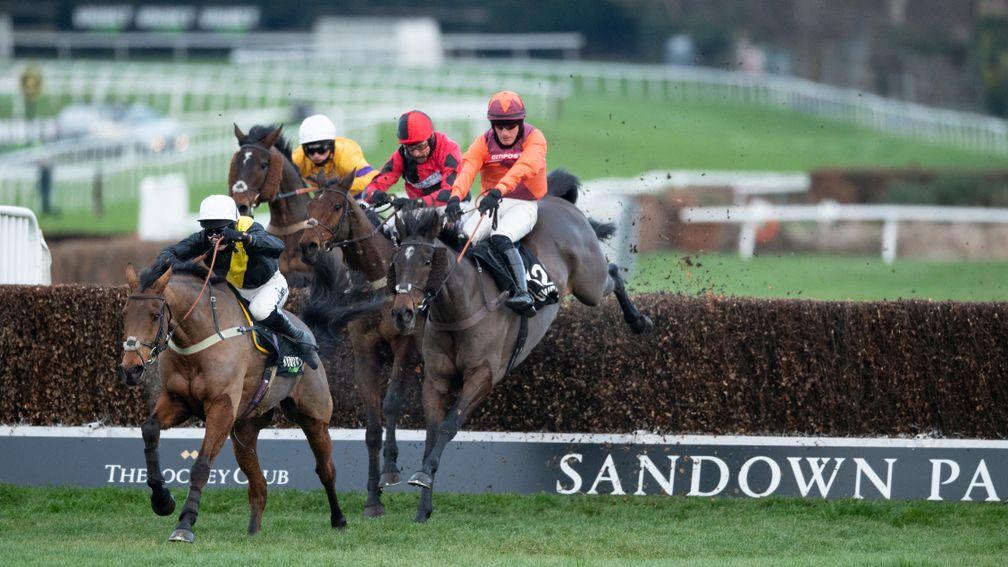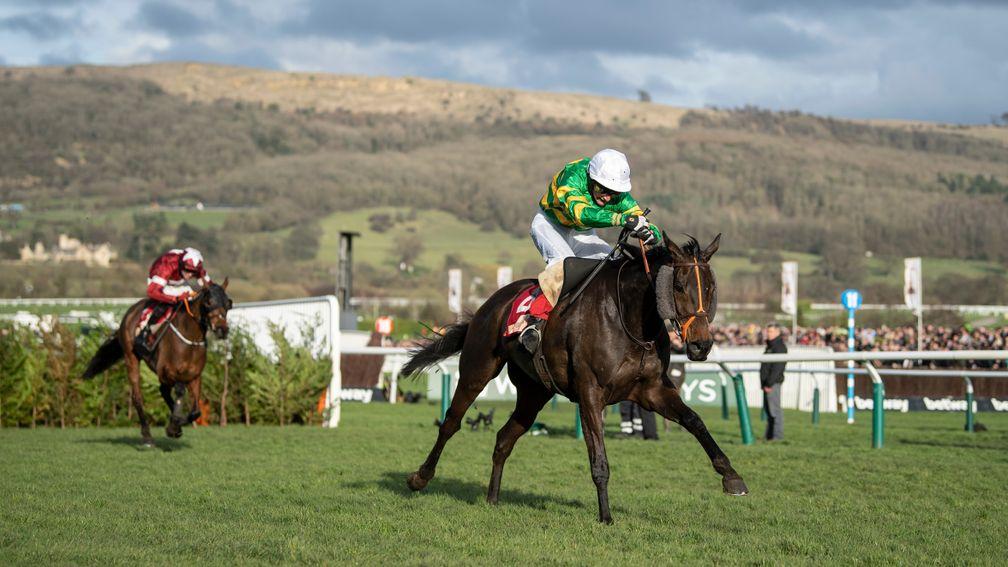The veterans' series is a monumental success - and it is vital it stays as it is

Universal approval isn’t something that is seen very often in the racing world, yet everyone seems to agree the veterans’ chase series, which concluded at Sandown on Saturday, has been a resounding success.
The final exemplified why the series has become such a firm favourite since it was first run in 2016. Worth more than double the value of the Grade 1 Tolworth Hurdle to the winner (a concerning comparison), Saturday’s race attracted 15 runners, with the bookmakers betting 5-1 the field. The top-rated horse was 148 and finished second, while a 13-year-old came out on top. Both the winning horse and rider had retired and returned, and Seeyouatmidnight’s success under Ryan Mania was yet another reminder of trainer Sandy Thomson’s skill.

Some believe the race deserves a place at the Cheltenham Festival, but to move it there would be a needless switch that would only perpetuate one of the sport’s biggest issues.
The final should stay at Sandown because it works. The qualifying system and race placement ensures high-quality horses are seen out at various tracks as early as October and (lo and behold!) can still run at the spring festivals once the veterans’ series is over.
An event shouldn’t have to take place at Cheltenham in March to be great. Such is the current programme and an often tunnel-vision approach to those four days in March, we can be starved of competitive action on a weekly basis as connections merrily plot the briefest and easiest routes there.
The veterans’ chase series offers older horses the chance to win again, en route to and in the final itself, independent of Cheltenham. As well as taking place at premier tracks like Aintree and Sandown, this season’s qualifiers also included courses like Warwick, Leicester and Kelso. Because of this, the series has gone a small way in redressing a toxic balance and for that it should be celebrated.
What is so wrong about a well-established, well-contested race outside of the festival? We don’t have enough of them.
While a veterans’ race at Cheltenham would be undeniably popular, it would take away from the current race at Sandown, which provides the Tolworth card with additional support. It would also be to the detriment of existing festival races like the Kim Muir and Cross Country. Like every top race, they should be as undiluted as possible.
The beauty of the current series format is that there is nothing to say the likes of Seeyouatmidnight and Crosspark can’t go on to run in those races if deemed suitable.

It is also worth mentioning the BHA introduced an equivalent series for lower-rated veterans (ranging from 0-120 to 0-125) restricted to conditional riders in the 2019-20 season. Like the Class 2 version, the 12 qualifiers were spread up and down the country with a series culminating in a final worth £50,000 at Newbury.
Not only does this give lower-rated horses more opportunities, but it provides up-and-coming riders with more races in which to showcase their skills.
Sandown clerk of the course Andrew Cooper has no doubt the veterans’ series has swiftly become a huge attraction. The race’s increasing popularity could even mean the day is renamed in its honour.
So let’s continue to give the veterans their own stages on which to shine, while simultaneously providing a boost for less-heralded tracks along the way.
I was against the abolition of the festival’s novice handicap chase in particular, but the Cheltenham programme ultimately needs less, not more. Instead of feeding an already bloated beast, let’s focus on improving the quality of racing elsewhere – the veterans’ final has been so successful because it has done just that.
Fox a feelgood story for all
The year 2020 was a turbulent one for racing, and not simply because of the coronavirus pandemic. The industry also faced criticism over some self-inflicted wounds, from botched photo-finishes to the Delia Bushell affair.
But light has pierced the gloom. The sport has adhered to Covid protocols almost flawlessly amid the pandemic, ITV signed another television deal and covered countless more racedays and horses like Envoi Allen, Shishkin and Frodon have illuminated the bleak winter months.
Sport, and for many of us racing in particular, is a tonic in times like these, something that has been exemplified many times in the past week alone.
One story from the other side of the world stands out. On New Year’s Day, a horse called Little Red Fox won a maiden plate under apprentice jockey Mikaela Lawrence at country racecourse Burrumbeet in Victoria, Australia.
Having ridden the mare on her second start for a previous trainer in April 2019, Lawrence and her family bought Little Red Fox at Euchuca Horse Sale 12 months later, not wanting her to be sold for pet meat and with the intention of giving her a home, for just A$382 (£216).
Friday’s win was not only Little Red Fox’s first victory in the family’s pink and white colours, but also gave trainer Emma Collins her first winner.
Feelgood stories like this are often lost in the gigantic world of racing, but they are what keep so many going in tough times and have the potential to uplift whole communities. Let’s hope for more of the same in 2021.
Playle's play
Hold That Taught
1.58 Chepstow, Saturday
After the recent wins of Royal Pagaille, Funambule Sivola, and Ibleo, now is the time to start latching on to Venetia Williams-trained handicap chasers. This race has the potential to be competitive, but Hold That Taught was behind two progressive young chasers in Demachine and Young Bull at Ascot when last seen and will be much more at home on this galloping track. He's a good jumper for one so inexperienced and surely will end up better than a mark of 123.
Playle's lay
Springfield Fox
3.10 Chepstow, Saturday
The Welsh Grand National usually turns into a war of attrition and you either need a well-handicapped or classy horse to win it. Springfield Fox has potential, but he's had only three starts over fences and he has hit the first on his last two runs (unseated later on in National Hunt Chase). His technique means he can jump quite low and, while that can be an advantage, Chepstow's fences are stiff and getting into a rhythm is key. His jumping will be put under pressure here and he can't afford to make a mistake.
Read more from Maddy Playle:
No allowance needed: why a 25-1 shot should be added to your ante-post portfolio
Yorkhill transformation a feat which deserves joyous celebration
Arkle dark horse has what it takes to tackle red-hot Shishkin
If racing is to develop it's vital it listens to those who speak out on race
The Weekender is out every Wednesday and is available at all good stores. You can also download the edition from 9pm on Tuesday evening
Published on 6 January 2021inComment
Last updated 17:55, 6 January 2021
- The whole shape of the Irish Flat season is being defined by one man only - and even his main targets lie elsewhere
- Analysis: Flutter and 888 have enjoyed contrasting fortunes but they still have things in common
- Only a baby step but an important one if racing is to keep some of its David v Goliath moments
- There are so many great betting opportunities on Saturday - here are my best bets including a very strong Curragh fancy
- Coolmore and Godolphin spare the sport some embarrassment - and not for the first time
- The whole shape of the Irish Flat season is being defined by one man only - and even his main targets lie elsewhere
- Analysis: Flutter and 888 have enjoyed contrasting fortunes but they still have things in common
- Only a baby step but an important one if racing is to keep some of its David v Goliath moments
- There are so many great betting opportunities on Saturday - here are my best bets including a very strong Curragh fancy
- Coolmore and Godolphin spare the sport some embarrassment - and not for the first time